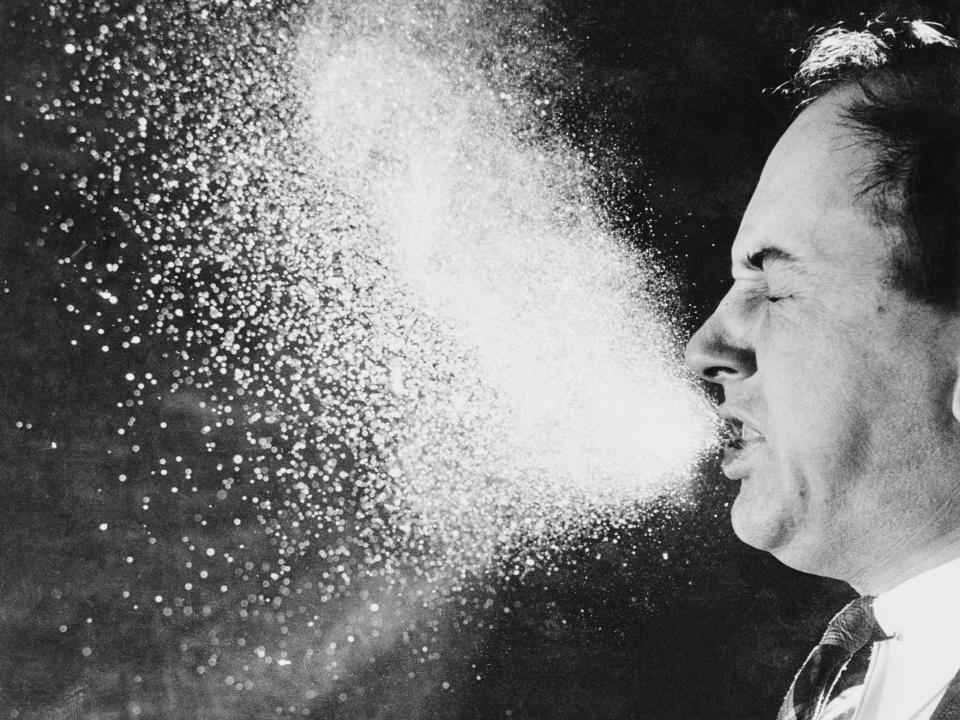The CDC is retracting new guidance that the coronavirus can float beyond 6 feet in poorly ventilated spaces

Bettmann/Getty Images
The Centers for Disease Control and Prevention on Friday acknowledged for the first time that the coronavirus could "remain suspended in the air."
The new CDC guidance was retracted on Monday morning — the agency said "a draft version" had been "posted in error."
The CDC has retracted advice several times in recent months under pressure from the White House. In this case, insiders say it was an internal mistake.
The now-retracted phrasing lined up with studies from around the world that suggested the virus could linger and float through the air, especially indoors.
Singing, shouting, talking, and spitting can all help the virus spread.
Six feet may not be enough to protect you from the coronavirus, especially indoors.
That's what the US Centers for Disease Control and Prevention had said in updated guidance posted on its website on Friday, in line with findings from studies around the world.
But by Monday morning, the advice had been retracted.
The agency had acknowledged last week for the first time that the coronavirus "can remain suspended in the air and be breathed in by others, and travel distances beyond six feet."
However, the updated language was pulled off the federal agency's website on Monday, even though it is backed by a large and growing body of evidence: The coronavirus spreads well among people who are indoors, shouting, singing, eating, and breathing together, even at a distance.
Reached by email on Monday, a CDC representative told Insider that a "draft version" of the new guidance had been "posted in error to the agency's official website" and that the official recommendations were still being updated.
The agency said in a follow-up email that internal "concerns" about the language on transmission had "led to revision of the 'How COVID-19 Spreads' web page without appropriate in-house technical review."
"We are reviewing our process and tightening criteria for review of all guidance and updates before they are posted to the CDC website," the agency said.
The CDC has previously U-turned on coronavirus advice, often under pressure
The guidance the CDC had laid out was nothing revolutionary, merely clarifying what many other scientists and public-health experts have said in recent months.
In July, the World Health Organization, which, like the CDC, is constantly reviewing new scientific evidence about how the virus spreads, acknowledged that the virus may float beyond 6 feet, especially indoors.
The truth is that people and the tiny particles they breathe, shout, sing, sneeze, and cough out are the greatest viral threat right now — not surfaces, and not contaminated groceries or mail.
As Americans head into the chillier fall and winter months, with the novel coronavirus still in circulation, it'll be an important point to remember: Being inside with this virus is dangerous, and wearing a mask when indoors is an important infection-prevention technique.
And yet, the advice was pulled.
The move feels similar to other retractions the CDC has recently made in the face of pressure from the Trump administration.
Last month, the CDC watered down its coronavirus testing recommendations, which was widely condemned by public-health professionals and eventually reversed.
Before that, the CDC shelved detailed tips for how businesses and schools might reopen safely during the pandemic, again after pressure from the administration.
"I don't think there has ever been a time before when people from the White House or HHS are dictating what goes on technical documents on the CDC website," Tom Frieden, a former CDC director, previously told Insider. "This is dangerous."
The CDC's original guidance may not be enough in every setting

Before this back-and-forth, the last time the CDC updated its guidance on how the virus spreads was June.
Since then, scientists have learned much more about the best ways that the coronavirus hops from person to person, as the illness has continued to move around the world.
In a widely reported investigation into a March choir practice in Washington state, investigators found that more than 50 people got COVID-19, the illness caused by the coronavirus, from one sick choir member, even though they were all social distancing (but not wearing masks) during practice. Two people died.
In May, the CDC even issued "interim guidance for communities of faith" warning against group singing activities during the pandemic. But the guidance was yanked off the agency's website after only a day, because the White House hadn't approved the change.
That guidance pressed that certain high-transmission indoor settings — "during choir practice, in restaurants, or in fitness classes" — have some common features: They're crowded, poorly ventilated places where people can spend a "prolonged period of time" with infected people.
The CDC had said the virus 'can remain suspended in the air' and 'travel distances beyond 6 feet,' but the guidance was pulled

Being outdoors with others is better than hanging out inside. There's lots of room for the virus to dissipate after leaving a sick person's nose or mouth, as long as you're not getting too close.
It also helps to have a good ventilation system, as many hospitals and airplanes already do. Or to open a window.
"If ventilation is good, it is not a threat, because the virus is not in the air," Lidia Morawska, a leading aerosol scientist in Australia, recently told Insider.
Wherever you are, keeping a good measure of distance between yourself and others is still a good idea. If you're indoors or in a crowded space, keeping your mask on, staying quiet, and making interactions brief can all help mitigate the spread.
"It's not rocket science to work out what needs to be done to minimize the risk of infection transmission," Morawska said.
Read the original article on Business Insider

